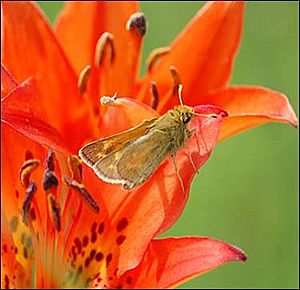Dakota skipper facts for kids
Quick facts for kids Dakota skipper |
|
|---|---|
 |
|
| Conservation status | |
| Scientific classification | |
| Genus: |
Hesperia
|
| Species: |
dacotae
|
The Dakota skipper (scientific name: Hesperia dacotae) is a small butterfly found in North America. It's about one inch wide, which is roughly the length of your thumb. These butterflies are known for their unique antennae that curl into a hook shape.
Contents
What Does It Look Like?
Male Dakota skippers have wings that are a mix of tawny-orange and brown. Their front wings have a clear mark, and the lower part of their wings is a dusty yellow color.
Female Dakota skippers look a bit different. Their wings are a darker brown-orange. They also have white spots along the edges of their front wings.
Life Cycle of the Dakota Skipper
Adult Dakota skippers have a very short life. They are only active for about three weeks, usually in June and July. This short time is their entire adult life!
During this period, the females lay their tiny eggs on the underside of grass leaves. These eggs hatch into caterpillars in July. The caterpillars then spend their time eating native grasses.
As late summer arrives, the caterpillars become dormant. This means they go into a deep sleep. They spend the entire winter in small shelters very close to the ground. When spring comes, they wake up and change into their adult butterfly form.
Where Do They Live?
Dakota skippers live in healthy natural areas. They prefer tall grass and prairie lands. You can find them in places from Minnesota all the way to Saskatchewan in Canada.
Sadly, they are no longer found in Illinois and Iowa. The biggest and healthiest group of Dakota skippers now lives in North Dakota.
Why Are They in Trouble?
The number of Dakota skippers has been going down. This is mainly because their natural homes, the prairies, are being destroyed or changed.
Prairies are often used for grazing animals like cows. They are also changed by using chemicals to kill plants (herbicides) or by building new things. All these activities harm the places where the skippers live and find food.
Protecting the Dakota Skipper
People have been working to protect the Dakota skipper for a long time. The U.S. Fish and Wildlife Service considered protecting them from 1975 to 2014.
Groups also asked for their protection in 1994 and 2003. Finally, in 2014, the Dakota skipper was officially listed as a "Threatened" species under the Endangered Species Act. This law helps protect animals and plants that are at risk of disappearing forever.


